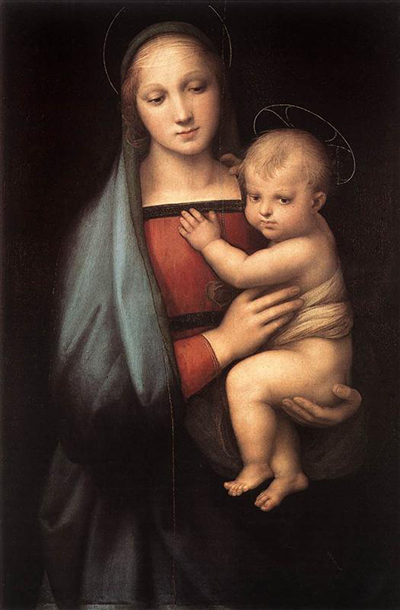The Renaissance artist Raffaello Sanzio da Urbino known for his religious figureheads showcase yet another piece that was added to his unending collection of the religious culture in the year 1504.
The painting is a plain portrait of the Virgin Mary holding the young Jesus. This portrait was developed immediately Raphael arrived in Florence from his hometown. The painting's original owner is dated back to Ferdinand III the Grand Duke of Tuscany. It was formally known as Madonna Del Granduca a name inspired by the Grand Duke.
This is a more symbolic Christian art and it is known to be very influential among many Christians. This beautiful artwork shows his more subtle approach to come up with a great piece of art while maintaining its overall simplicity. The painting was first made by Carlo Dolci who was a renowned Florentine painter. Raphael later came up with this version which got the best reception than its initial version.
During its development in 1504, the high renaissance was still in play and so the technique used was obviously oil on panel. This Technique gained more prominence than the temperate one which from the look of things wasn’t as effective. All the painters are seen to use oil on panel throughout their paintings. Raphael was influenced by the Peruginesque and Leonardesque to come up with this lovely art. Peruginesque and Leonardesque were the methods used to create unique artworks by both his teacher Perugino and his mentor Leonardo da Vinci. He is seen employing them on the Grand Dukes Madonna painting to create a very interesting piece. The level of his creativity is unparalleled, he delivers this portrait so effortlessly and it feels like he does them with ease and composure while most artists struggled to deliver their best work which still couldn’t beat his.
Using his immense artistic wisdom, he develops a very simple portrait with crispy clear features that makes it even more unique. Virgin Mary is seen under a hallow signifying her holiness gazing away from the audience. She seems rather calm though not jovial. She clutches baby Jesus who has made an attempt to raise his head. The clock flowing from the Virgins shoulder is quite clear and detailed while her garment though very simple showcase a sense of style. Raphael is seen to put immense concentration on their faces to achieve a certain type of mood on the characters. The Virgins’ hair is well done though most of it is concealed by a headscarf which seems to be the same one flowing down past her shoulders. The baby, on the other hand, holds on the mother in complete realism.
This painting shows a special relationship between the mother and the son. He achieves a creative form of simplicity by effortlessly coming up with a very good piece of two characters who make up part of the holy family. The current location of the painting is documented to be at Palazzo Pitti in Florence Italy same geographic region it was developed.




